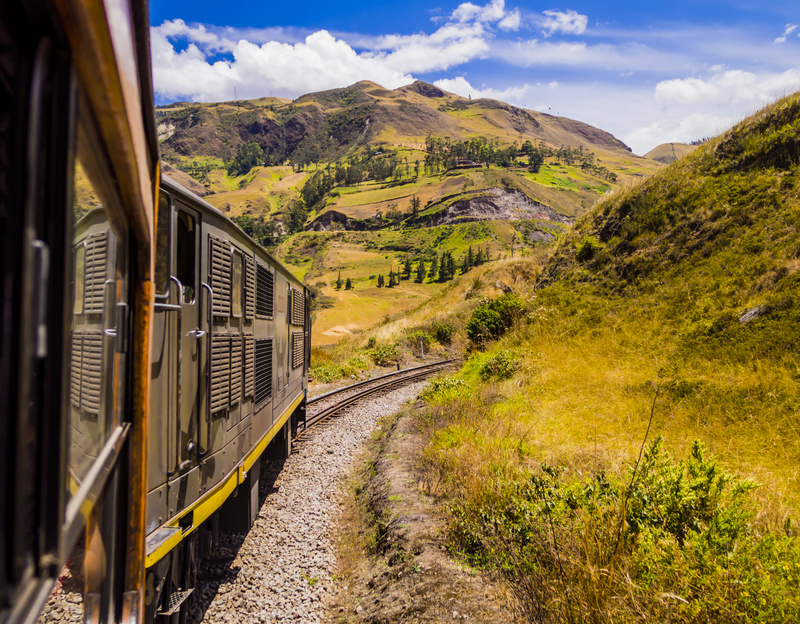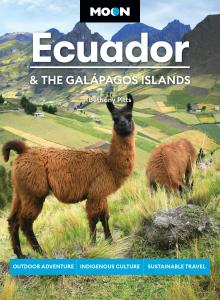Visiting Alausí and taking the Nariz del Diablo Train Ride
The charming town of Alausí has even more spectacular experiences to offer than the Devil’s Nose train for which it is most famous. In fact, those who only come for the train ride are doing themselves, and Alausí, a great disservice. Perched on the edge of a dramatic gorge and surrounded by mountains, the setting is magnificent. In the town center, presided over by a giant statue of Saint Peter on a hill, the railway tracks are flanked by pastel-colored colonial houses on cobbled streets. Every Sunday, Indigenous people in traditional colorful clothing come from the surrounding rural communities to trade their handicrafts and fresh produce in the lively market. Alongside Patate, Alausí has rightly been named one of the country’s Pueblos Magicos (Magical Towns).

Visitors can climb the Lluglli hill to gaze upon the panoramic views from the Saint Peter statue, or follow the railway tracks to the northern end of town to admire the impressive Puente Negro, a 200-m (656-ft) bridge spanning the river gorge, built in 1903. There’s not much else to do in Alausí itself, apart from wandering the picturesque streets or watching the light change on the surrounding peaks and valleys, but this very tranquility is part of its charm. In many ways, a trip to Alausí is like taking a trip back in time and, if you’re anything like this travel writer, you may not want to leave.
While the cobbled streets might tempt one to amble, the surrounding countryside is an invitation to get active. Alausí is the jumping-off point for some spectacular hikes, with April and May the best months to visit, for the clear skies and wildflowers.
Newsletter Signup
By clicking ‘Sign Up,’ I acknowledge that I have read and agree to Hachette Book Group’s Privacy Policy and Terms of Use
Nariz del Diablo Train Ride

The Devil’s Nose was one of the most incredible feats of railroad engineering when it was completed in the early 1900s as part of the train line linking the Andes with the coast. To descend the almost perpendicular slopes of the Cóndor Puñuna or Sacred Condor’s Nest mountain, the tracks make a series of switchbacks that are so tight the entire train has to back up to fit through, descending over 500 m (1,640 ft) in just 12 km (7.5 mi). A high price was paid for this wonder of the steam age; over 4,000 people lost their lives during construction, most of them Indigenous locals and Jamaican enslaved people—hence the name, Nariz del Diablo.
When it opened, the train line was used to transport goods and passengers between the coast and the Sierra. Suddenly, trade between the two regions was possible in hours, rather than days. With three classes of tickets, rail travel was affordable for local people, boosting the economy along the whole route. In the 1990s, following years of neglect and some devastating landslides, the train line was closed and fell into disrepair, before the Devil’s Nose section was renovated and opened as a tourist attraction. Sadly, the ticket prices are out of reach for most locals these days.
Note: The Devil’s Nose train was closed once again in May 2020. Efforts are being made to reopen it, but it is not known when it will be fully operational. Check the current situation with the tourist office (Facebook @visitalausi) before making plans.
During the 45-minute journey, there is a guided tour in English and Spanish. Just after the switchbacks, the train stops for an hour near Sibambe before turning around and climbing back through the entire route to Alausí. During the stop, passengers can spend time in the museum, the café, or the shop, which sells handicrafts made by local communities. Dancers from the nearby village of Tolte perform a traditional folk dance.
Alausí’s train station sits behind the small plaza at the north end of the main street, 5 de Junio. The train departs twice daily (except Mon.) at 8am and 11am ($33). The return journey takes 2.5 hours. Tickets should be bought in advance, especially on weekends, and are available at the train station in Alausí. For the best views, sit on the right-hand side of the train.
Hiking
While the famous train ride is somewhat of a tourist trap, it’s possible to hike from Alausí into the nearby mountains, where a mirador overlooks the dramatic zigzagging tracks of Devil’s Nose, providing a much better view than from inside the carriages. If you time it right, you can see the train going past. Best of all, you’ll probably have the whole scene to yourself, or perhaps share it with a local campesino. Here, people live much as they have for centuries, wearing brightly colored ponchos as they ride on donkeys or walk miles every day with their sheep, faces bronzed and lined by the sun. The hike also passes the small village of Nizag, where people weave bracelets, hats, and bags out of the sisal plant. The hike takes half a day. From the train station in Alausí, the trail skirts the train tracks for the first 2.5 km (1.5 mi), then continues for another 4 km (2.5 mi) to the peak of the Condor Puñuna mountain. The trail is marked on Maps.Me.

Alausí is also an excellent jumping-off point for the Lagunas de Ozogoche, a beautiful series of lakes high in the pristine páramo of Sangay National Park. The lakes are best known for a mysterious phenomenon that takes place annually in mid-September, when hundreds of migrating plovers, cuvives, appear to commit suicide by diving into the water. The Kichwa people see this as a tribute to the Pachamama (Mother Earth) and organize a festival, with rituals, music, and dancing. The entrance to the lakes is an hour’s drive east of Alausí and, on a clear day (more likely May-November), the journey is a joy, with views of Chimborazo in the distance. The road also passes some traditional dwellings made of mud and straw, where a few people continue to live an astonishingly hard life on the windswept páramo with their livestock. To get there from Alausí, take the Panamericana north for 21 km (13 mi), then turn on to the Vía Ozogoche at Charicando, from where the lakes are another 32 km (19.8 mi). It’s possible to drive all the way to the largest lake, Cubillín, although the last part of the road is unpaved. From Cubillín, a trail leads 1.5 km (0.9 mi) to the second biggest lake, Macatayan.
Half an hour from Alausí, Achupallas is the starting point for the three-day Inca Trail to Ingapirca, the largest known Inca ruins in Ecuador. Achupallas also has waterfalls, lakes, and some giant petrified shells. A round-trip by camioneta costs $12. Community Hostel can organize the Inca Trek for $250 per person, including tents, meals, and rubber boots.
Tours
Alausi Tours (Simón Bolívar 161 y Pedro de Loza, tel. 32/930-501 or 99/060-0702, www. alausitours.com) offers one-day local tours including the Devil’s Nose train ride (if run- ning) combined with a tour of Alausí ($40 pp); the Devil’s Nose hike ($20 pp); the Lagunas de Ozogoche ($30 pp); a hike to Nizag ($20 pp); a Chimborazo day trip ($49 pp); and an Ingapirca day trip ($46 pp). Two-and three-day tours combine these activities. The Inca Trail to Ingapirca is available for $200 per person (one or two days) or $300 per person (three days), including transport, tents, a local guide, and a horse to carry the equipment. Prices given are for a group of two people.
Food and Accomodations
The municipal market (García Moreno entre Pedro Loza y Chile, 8am-7pm daily) has fresh produce and a food court with local dishes, including hornado (roast pork).
The best place to eat is Estación del Tren (Calle Ricaurte entre Av. 5 de Junio y Antonio Mora, tel. 3/293-0952 or 97/994-5147, 8am-10pm daily, $3.50-7), opposite the train station. Owned by a friendly local family, the restaurant uses organic produce, with vegetables from small-scale farmers in Nizag, fruit from the family farm, and coffee from Loja. Many of the recipes come from a 90-year-old nun’s grandmother’s secret recipe book. The menu includes breakfasts, set lunches, steak, pork chops, and pasta. The chef can whip up a wonderful vegetarian meal. The dessert specialty is passion fruit mousse.
Next to the railway tracks, El Mesón del Tren (Ricaurte y Eloy Alfaro, tel. 96/271- 2631, 8am-1pm daily, $5-9) offers set lunches and à la carte Ecuadorian dishes including pork chops, lamb, steak, grilled tilapia, and shrimp. Vegetarians can be catered to.
At the north end of town next to the railway track, the best place to stay is Community Hostel (Eloy Alfaro Casa 172, tel. 99/358-5619, WhatsApp +1 858/382-2145, $10 dorm, $20-50 s/d). It’s owned by local septuagenarian legend Marco Tulio Fiallo, who converted his childhood home into the hostel. It’s immaculate, offering luxurious accommodations and gourmet breakfasts. A great spot for digital nomads, with fast Wi-Fi and lots of plug sockets, it’s a sister establishment to the excellent hostel of the same name in Quito. Don Marco, who speaks fluent English, takes guests on free hikes to the Devil’s Nose mirador and Nizag; leads tours to the Ozogoche lakes ($50 for 1 person, $25 pp for 2-4 people); and can organize the Inca Trek.
Most other accommodations are on the main drag, the 5 de Junio. Hotel Europa (5 de Junio y Esteban Orozco, tel. 3/293- 0200, $18-25 s, $30-44 d) has friendly service and rooms to suit different budgets, with private or shared bathrooms. Breakfast is available for $3.50. Family-owned Hotel Noris (5 de Junio 122 y Pedro de Loza, tel. 3/293-1112 or 99/061-2143, $25 s, $40 d) has attractive guest rooms and a third-floor mirador overlooking the Saint Peter statue. The restaurant serves traditional food.
Located 1.5 km (0.9 mi) southwest of the town center is Killa Wasi (La Quinta de la Familia Rivadeneira, Barrio Mullenquiz, tel. 98/947-6530, $5 camping, $10 dorm, $15-20 s/d). Set on an organic farm, the hostel is run by a friendly local mother-and-son team. Guest rooms are clean with comfortable beds and shared or private bathrooms. The common area walls are painted with motifs from Inca and Kichwa mythology. Delicious meals made with produce from the farm are available, with vegetarian options. The trailhead for the Nariz del Diablo hike is next to the hostel.
Information and Services
The tourist information office (https://alausi.gob.ec, Facebook @visitalausi, Instagram @pueblo_magico_alausi 8am-noon and 2pm-6pm Mon.-Fri.) is next to the train station on 5 de Junio. A hundred meters south is a Banco Pichincha ATM.
Getting There
Cooperativa Alausí (CTA) buses depart from the terminal on 5 de Junio. There are departures to Riobamba (every 30-60 minutes 5:10am-6:30pm, 2.5 hours, $2.70); Cuenca (6:30am and 10:30am, 4 hours, $7.20); Quito (4am, 8:10am, 10am, and 1:30pm, 5.5 hours, $8); and Guayaquil (4am, 9am, and 1pm, 5 hours, $7.20). There are buses to Alausí from Riobamba (every 30-60 minutes 5am-9pm); Cuenca (5am, 2:45pm); Quito (7:25am, 9:25am, 12:25pm, and 5:25pm); and Guayaquil (6:15am, 1pm, and 4pm).
Cooperativa Patria (Colombia y Moreno) has an office just off the Panamericana to the southeast of town. Buses leave for Cuenca ($6-8) at 7:15am, 9:30am, 11:30am, 1pm, 3pm, and 5:30pm, and for Quito ($7) at 8am, 9:30am, noon, 1:30pm, 3:30pm, and 6pm.
More buses pass on the highway up the hill ($1 by taxi), picking up passengers at the gas station on the Panamericana.
Newsletter Signup
By clicking ‘Sign Up,’ I acknowledge that I have read and agree to Hachette Book Group’s Privacy Policy and Terms of Use
Pin It for Later


